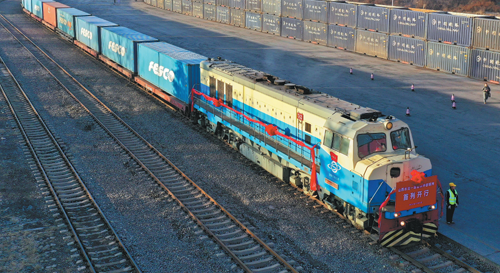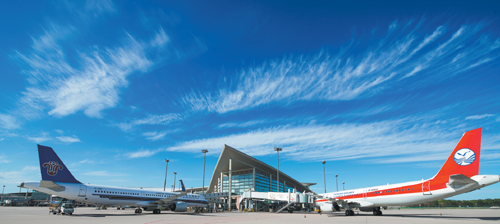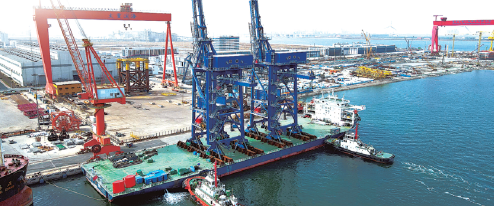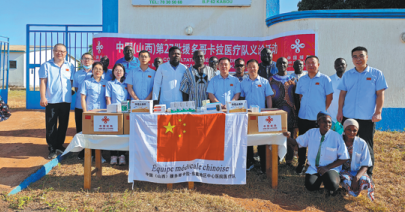Shanxi on track to making economic and cultural connections around the world

Province aims to be 'new highland for opening-up of inland regions'
As one of the hubs of the ancient Silk Road, the North China province of Shanxi is playing an increasingly important role in the Belt and Road Initiative.
The Silk Road Economic Belt and the 21st-Century Maritime Silk Road, also known as the Belt and Road Initiative, is an international development program proposed by the Chinese authorities in 2013. It focuses on connectivity and cooperation among countries and regions throughout the world. To date, more than 150 countries and regions are involved.
Shanxi, known for its international trade developed by the famed Shanxi merchants, had been a key player in international economic and cultural exchanges via the ancient Silk Road during the Ming (1368-1644) and Qing (1644-1911) dynasties.
In this new era of globalization, the province has positioned itself as "a new highland for the opening-up of China's inland regions". To fulfill this ambition, it has highlighted economic and cultural exchanges with countries and regions involved in the BRI.
One of Shanxi's efforts is to improve connectivity with Belt and Road countries and regions by building convenient land and air transport networks.
Through expanding the channels for international trade, such as international cargo flight services and the freight train services destined for Europe, Central Asia and Southeast Asia, Shanxi is pushing its opening-up initiative to a higher level.
Taiyuan Wusu International Airport, the leading international airport in Shanxi, for instance, has been expanding its overseas business in recent years.
On Oct 21, a 737-800 cargo plane carrying 11.2 metric tons of local products departed from the Taiyuan airport and arrived in Almaty in Kazakhstan about six hours later. This marked the inauguration of airborne cargo transport between Shanxi and Central Asian countries.
Shanxi now has three airports — in Taiyuan, Datong and Yuncheng — operating international cargo transport services.
Freight train services bound to destinations in Europe, Central Asia and Southeast Asia are an important channel for Shanxi's international trade and economic exchanges.
On Dec 21, a China-Europe train loaded with China-built cars arrived at the Bely Rast Station in Moscow, Russia, after traveling more than 8,000 kilometers.
This train, departing from Changzhi city, marked the beginning of China-Europe freight trains in the southeast of Shanxi.
Shanxi has established a regular service network for freight trains to reach overseas destinations. There are 15 routes dedicated to China-Europe freight train services, reaching 48 major cities in 16 countries.
The China-Europe freight train service, as well as the train service to other destinations in the world, allows Shanxi-made products to go global at lower costs from their doorstep, enhancing local companies' confidence in pursuing overseas opportunities.
One company benefiting from the better connectivity as a result of the BRI is Taiyuan Heavy Machinery Group. It is a major manufacturer of advanced mining machines and rail transit equipment like smart hydraulic excavators and train wheel sets.
Over the past decade, the company has developed a presence in more than a dozen Belt and Road countries including Uzbekistan, Indonesia, Kazakhstan, the Philippines, Turkmenistan, Belgium, Romania and Austria.
In 2024, the company saw a 25.6 percent year-on-year increase in its delivery of export orders and a 25 percent rise in overseas sales revenue. The 18 Belt and Road countries serving as Taiyuan Heavy Machinery Group's major export destinations accounted for more than 68 percent of the company's exports.
Local financial institutions, including the Shanxi branch of the Export-Import Bank of China and the Shanxi branch of the China Export& Credit Insurance Corp, are also supporting Shanxi enterprises' expansion in Belt and Road markets.
Xin Gang Lian Metallurgy, based in the county of Pinglu, is a major iron alloy manufacturer in Shanxi. It mainly imports ore and other raw materials from Belt and Road countries, with an annual value of more than 10 billion yuan ($1.38 billion). However, insufficient cash flow to meet the demand has been a pressing concern for the company in recent years.
Learning about this, the Shanxi branch of the Export-Import Bank of China, which is also known as China Exim Bank, immediately offered a credit line of 550 million yuan to the company in March 2023.
"The loan from China Exim Bank Shanxi has not only effectively solved our bottleneck for development, but also helped us save costs worth millions of yuan a year, because of its preferential interest rate," said Wei Jun, an executive of Xin Gang Lian. "And more importantly, we are being offered access to the bank's lending in the years to come."
Sources from China Exim Bank Shanxi said that the bank has offered loans totaling 57 billion yuan to help local companies build or operate infrastructure, energy and manufacturing projects relating to the BRI.
The Shanxi branch of the China Export & Credit Insurance Corp has offered insurance for 11 new energy-related projects built by Shanxi companies in Belt and Road countries in 2024, including solar farms in Singapore and Eritrea. The insured amount of these projects totaled $600 million.
One of the aims of the BRI is to build a global community with a shared future, so people-to-people exchanges are a priority in Shanxi's engagement in the initiative.
To help to realize common prosperity among people, Shanxi has strengthened exchanges in the areas of culture, education and healthcare with countries and regions involved in the BRI.
Shanxi started its healthcare cooperation with Belt and Road countries, especially those in Africa, long before the BRI was launched.
In 1975, Shanxi began to dispatch medical aid teams to Africa. Since then, a total of 1,449 medics in 70 teams have offered their services in African countries including Cameroon, Togo and Djibouti. It is worth mentioning that Shanxi's doctors have used traditional Chinese medicine to successfully treat patients in those countries, contributing Chinese wisdom to the local healthcare industry.
Cooperation in education is another important pillar of Shanxi's exchange with Belt and Road countries and region.
Taiyuan University of Technology and Shanxi University, for instance, have established Confucius Schools in countries including Jamaica, Afghanistan and East Timor, getting local students familiar with the Chinese language and culture.
Shanxi Engineering Vocational College has joined hands with Xin Gang Lian Metallurgy to establish an online training program for the latter's local employees in Zimbabwe, helping them improve vocational skills and those in the Chinese language.
Shanxi Normal University has established a regular collaboration mechanism with some research institutions in the Middle East to promote academic exchanges.
As one of the cradles of Chinese civilization, Shanxi highlights the exchange among different cultures and civilizations. Shanxi Museum, based in the provincial capital of Taiyuan, is a major player in such exchanges.
The museum is planning an exhibition tour in Qatar in April to display the Buddhist cultural relics of the Tianlongshan Grottoes with the help of digital technologies.
The Tianlongshan Grottoes in Taiyuan include 25 caves filled with hundreds of Buddhist statues and relics. Construction on them began during the Northern Wei Dynasty (386-534) and lasted for another five dynasties, representing the peak of grotto art in ancient China.
Replicas made with digital restoration technology will be highlighted at the Qatar exhibition, giving visitors the opportunity to learn more about ancient Chinese culture.
The digital tours of Tianlongshan Grottoes began in 2019, with digitally restored replicas displayed in countries including France, Egypt and Greece.
Shanxi has also launched a friendly cities program to promote international exchanges. To date, Shanxi's cities have forged friendly city relations with 67 counterparts in 32 countries.
Zhang Qi and Wang Ningna contributed to this story.























